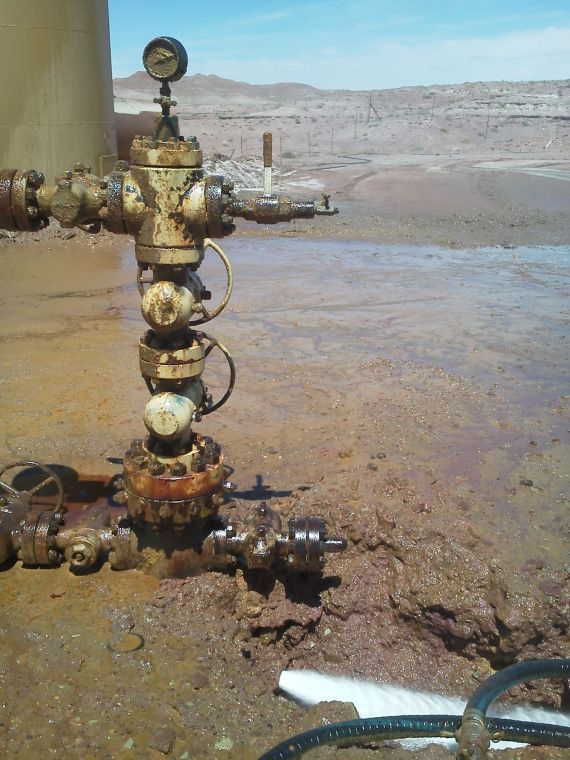The owner of an oil well that leaked hydrocarbons and briny water into a tributary of the Green River should not face significant penalties because it acted responsibly to mitigate the accident, state regulators announced last month.
The Utah Division of Water Quality is proposing to fine S.W. Energy $10,000 for violating the Utah Water Quality Act and other laws, following a May 2014 oil leak that sent pollutants into Salt Wash and the river.
That’s equal to the maximum daily civil penalty that the division could impose. However, the agency says it wants to give the Salt Lake City company credit for its previous history of compliance, and for its good-faith efforts to clean up the leak, instead of taking a more punitive approach.
Utah Division of Water Quality Director Walt Baker said his agency must follow a protocol to determine the appropriate penalty. In this case, he said, it considered the gravity of the situation, the severity of the discharge from the well and the company’s compliance history, among other things.
“We are comfortable that the penalty fits the crime, if you will,” he said. “It was an unfortunate incident, but we don’t think it was a negligence issue.”
But Living Rivers Conservation Director John Weisheit of Moab called the proposed fine an “arbitrary and diminutive” amount of money.
“It’s terrible,” he said. “They just polluted the Colorado River for 40 million people, and all they have to do is pay $10,000?”
Weisheit noted that many other oil wells in the region could drain into the Green and Colorado rivers, and he suspects that the owners of those operations will view the proposed fine as a cheap cost of doing business.
“I think (Division of Water Quality officials) are setting themselves up for other disasters,” he said.
S.W. Energy estimates that about 3,000 barrels of crude oil and saline “production water” escaped over the course of two days on May 21 through May 22, 2014, although it says that cleanup crews removed more than 2,700 barrels of liquids from the area. The company has said that the ratio of water to oil was 90 percent to 10 percent. However, that figure has been disputed, based on figures from the Utah Division of Oil, Gas and Mining, which state the ratio was more like one to one.
State regulators ultimately determined that a faulty valve was responsible for the leak, which occurred about 12 miles south of the town of Green River.
However, the water quality division found no evidence that S.W. Energy knowingly failed to maintain the broken valve – although it reported that the leak could have likely been prevented if the company had replaced the valve.
In the hours after a pumper first reported a large spray of fluid shooting out of the well head, the company “frantically” tried to locate a well service company to stop the leak, according to S.W. Energy President Rosanne S. Henshaw’s formal response to state regulators.
Crews finally killed the well some 30 hours after the leak was first discovered, and emergency cleanup workers began a 20-day remediation project at the site the next morning.
“Due to the quick action of so many people coming together, including the pumper, (S.W. Energy) operator, government agencies and the local construction and trucking companies, the emergency was contained in a timely manner,” Henshaw wrote.
Baker agreed.
“The company was very responsive,” he said. “The cleanup was aggressive.”
However, complications arose on the evening of May 23, 2014, when a major storm hit the area, and water from heavy rains sent the oily and briny liquids further down Salt Wash toward the Green River. Recreationists who were in the area submitted photographs that appeared to show an oily sheen on the river’s surface, although Utah Department of Environmental Quality Southeast District Engineer David Ariotti reported that it’s impossible to calculate how much petroleum reached the Green.
The water quality division collected three samples from the river over an eight-day period. None of them detected signs of contamination, although Baker said that some pollutants did flow into the river.
Ariotti reported that the soil in the wash likely absorbed most of the petroleum, “greatly” reducing the volume of material that the storm could have mobilized.
“I do not anticipate any long term impacts attributable to this event,” he said in a report about the leak.
Ariotti reported that any residual product in the wash has minimal potential to harm human or aquatic life, but Henshaw vowed that her company will continue to clean up the area, if necessary.
“This is a beautiful wash in a fragile desert environment,” she wrote. “We are committed to seeing this area heal and feel a personal responsibility to follow through.”
A pumper inspects the well every day, she wrote, and company operators will walk through Salt Wash on a quarterly basis to see how it is responding to the natural recovery process.
Southern Utah Wilderness Alliance (SUWA) field attorney Neal Clark of Moab said his group plans to review the settlement agreement and related state regulations, and then submit any comments, as warranted.
“Obviously, this issue is concerning, given that the Green River is such a world-class wilderness and recreation destination,” Clark said.
But it is not atypical, he said, and it could become more commonplace, as more and more abandoned or aging oil wells fall into disrepair.
Public comment on proposed S.W. Energy penalty open through Sept. 28
The Division of Water Quality is accepting public comments on its proposed action through Monday, Sept. 28. For more information, go to: www.deq.utah.gov/NewsNotices/notices/water/index.htm. Scroll down to “Enforcement Actions,” and go to “SW Energy, Docket No I14-08SA.”
We are comfortable that the penalty fits the crime, if you will … It was an unfortunate incident, but we don’t think it was a negligence issue.




